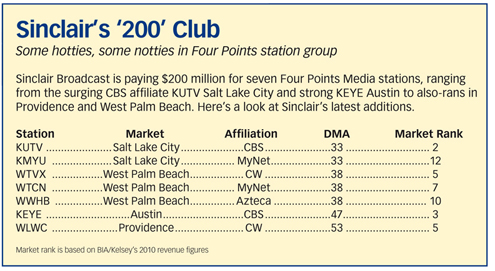Station M&A Forecast Remains Cloudy

The long-dormant station acquisition scene jerked to life Sept. 8 when Sinclair shook things up with its $200 million acquisition of the seven Four Points Media stations from Cerberus Capital Management. When Sinclair executives addressed Wall Street on a conference call that afternoon, group brass and analysts alike noted how somnambulant the station M&A scene had been.
“I had to take out my playbook and dust it off to see what the protocol is for M&A calls,” said Wells Fargo analyst Bishop Cheen. “It’s been a while.”
So limp has the market been that the largest station deals of late include London Broadcasting grabbing KIII Corpus Christi (Texas) for $31 million last year and Nexstar acquiring WEHT Evansville (Ind.) for $18.5 million last month. The drought has been prolonged by the prodigious gap between would-be sellers and buyers, with everyone waiting for that first big deal to set the benchmark for valuations in an era where no one really knows what a TV station is worth anymore.
Throughout its call, Sinclair’s executive crew, including President/CEO David Smith and Executive VP/CFO David Amy, stressed that the deal represents a 6 ½-times-cash flow multiple for Sinclair—reflecting both a blended average of 2010 and 2011 revenue and the synergies brought on by Sinclair’s massive scale (the group owns or services 58 stations). Analysts pestered Sinclair’s leaders to explain exactly how they came up with that number, and what the seller’s idea of the multiple might be. The broadcast chiefs repeatedly demurred before Amy finally shed a little light. The deal was “certainly nowhere near a 6 ½ as far as what Cerberus is looking at when they’re selling,” Amy said.
Through a spokesperson, Cerberus declined to say what sort of multiple it agreed to sell the stations for. Wells Fargo Securities crunched the numbers to come up with its own figure. “We think it was 8-9X, which says a lot about how undervalued broadcast TV is, trading at 6.4X blended 2011/2012,” Wells Fargo said in its Sept. 8 report.
The seven stations include major players such as CBS affiliates KUTV Salt Lake City, which can make a case for having overtaken longtime No. 1 KSL in DMA No. 33; KEYE Austin (Texas); and stations affiliated with lesser networks. Sinclair likes the deal because it involves middle-market stations and capital city markets and complements the group’s existing portfolio, it said on the Sept. 8 call. But Salt Lake City and Austin both slid down in Nielsen’s recently announced annual DMA rankings, with Austin dropping from No. 44 to 47 in 2011-2012 while losing more than 20,000 TV households. The financial troubles in Providence, R.I., are well-documented.
The deal nonetheless seems to have goosed Sinclair’s stock price, as it rose from around $7 before the announcement to $7.80 at presstime.
Without greater clarity coming from Sinclair’s Baltimore base or Cerberus’ Park Avenue digs, the extraordinarily murky station valuation picture remains, to many, pretty hard to decipher. “I don’t know that I learned anything about what it means for the market,” said one analyst who asked not to be named. “Sinclair says it’s 6½X and others say it’s 10X, and you could drive a truck through a 6 to 10X. I don’t feel like it gives us much direction.”
The industry lacks benchmark valuations, especially given the large number of stations on the block. Deadlines for bids have come and gone at Freedom and, more recently, McGraw-Hill. Nexstar is seeking a buyer, too.
Sinclair, for one, is not out of the running for subsequent acquisitions. “I don’t know if we can duplicate [a] 6½ [multiple], but if we find other opportunities that make sense from a multiples standpoint,” said Amy on the call, “we’re not going to ignore those.”
Even if Sinclair–Four Points didn’t exactly cough up a clear valuation multiple, analysts and bankers see the $200 million pact as a positive development. “I don’t know if it really sets the pace, but it does tell a story,” said one. “The message is, confidence has returned to the market.”
E-mail comments to mmalone@nbmedia.com and follow him on Twitter: @StationBiz
Broadcasting & Cable Newsletter
The smarter way to stay on top of broadcasting and cable industry. Sign up below
Michael Malone is content director at B+C and Multichannel News. He joined B+C in 2005 and has covered network programming, including entertainment, news and sports on broadcast, cable and streaming; and local broadcast television, including writing the "Local News Close-Up" market profiles. He also hosted the podcasts "Busted Pilot" and "Series Business." His journalism has also appeared in The New York Times, The L.A. Times, The Boston Globe and New York magazine.










